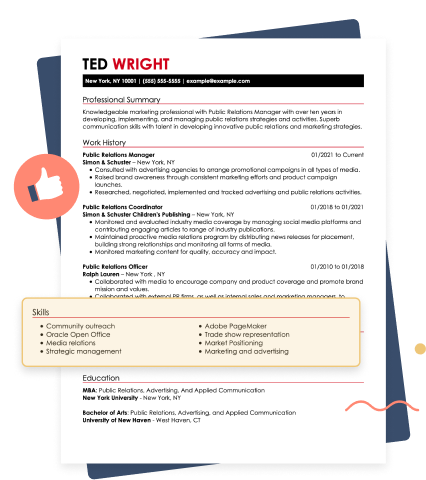How to Choose the Best Resume Paper for Your Application

Our customers have been hired at: *Foot Note
As the job market stands today, you might wonder if printing your resume is even necessary. However, the printed resume still has a place: job fairs, in-person interviews, or networking events, for example. And for those moments, you’ll want the best paper possible.
What Is Resume Paper?
Resume paper is high-quality, durable paper meant for professional and other formal documents. Unlike standard paper, it’s often thicker, has a different, refined texture due to the materials used, and is more durable.
Why you should use resume paper
When used strategically, a resume printed on professional-grade paper will communicate your attention to detail. It will help leave a memorable impression on recruiters and hiring managers. You can also:
- Bring printed copies to in-person interviews, even if you applied online and the company already has your resume.
- Hand out resumes at job fairs, networking events, or industry meetups to take advantage of any opportunities you come across.
- Keep copies at hand at all times, in case you meet someone in your industry or come across a company that interests you. This way you make sure to leave an impression at any moment.
Taking care of how your resume looks will impact how you’re perceived by employers, so choosing the right paper is as important as what you include in your resume.
What Makes the Best Resume Paper
There are four aspects to consider when choosing your resume paper:
- Material
- Texture
- Weight
- Color
Let’s review each one.
Material
When it comes to high-quality resume paper, cotton content is essential. Your paper's cotton content will determine its:
- Color saturation and depth
- Weight and thickness
- Crispness and softness
- Durability
Always look for a paper sheet with a cotton content of 75% or above. While this will make your options slightly more expensive, a higher cotton content ensures your resume looks and feels professional.
Texture
Resume paper comes in a variety of textures that affect the look, feel, and overall design of your resume. It also varies in terms of durability.
The most common and recommended textures are:
- Cotton: Your standard office paper. It’s durable, cheap, and the least flashy option.
- Linen: Features a subtle woven texture and adds a touch of sophistication.
- Recycled: An eco-friendly option if you want to demonstrate environmental consciousness.
- Granite: Speckled with natural fibers for a stone-like look, it adds weight and a bold, professional feel without being over the top.
Weight
Resume paper weight is a measure of the paper’s thickness and sturdiness.
Paper weight is measured per package of 500 sheets, also known as a ream. It typically comes in 20, 24, and 32 pounds.
For resumes, it’s usually recommended to use 24 or 32 pounds to produce a resume that feels impressive and official in the recruiter’s hands.
Color
Just like the overall feel, the color of your resume paper can subtly influence the reader.
For your resume paper color, it’s better to stick with white, ivory, or cream to maintain professionalism. These colors also ensure better readability as the dark ink will look crisp and pop off the page.
When choosing, think about the colors you have on your resume. Light, warm colors will shine more on white paper, for example.
Also, consider the context in which you’ll be handing out your resume, as well as your field and industry. For example, if you’re a graphic designer, a marketing consultant, or an architect, you may have more wiggle room for creativity. Using light gray or light blue-colored paper could make you stand out, as long as you have the design to go with it.
How to Choose the Right Resume Paper
Selecting the best paper for your resume boils down to your industry, personal brand, and, of course, budget. Here’s how to know which one is right for you:
Consider your industry’s standards
Each industry has its expectations for job seekers. For example:
- Traditional industries, such as law or finance: Opt for a linen texture or cotton with a high percentage in white or ivory color, and 32 pounds to achieve a sleek and professional look.
- Creative roles, like graphic design or advertising: A creative resume with bolder color choices, such as light blue and thicker paper that can handle heavy design, will impress employers.
- Retail or service jobs: Can go for a simpler, cotton white paper that’s more budget-friendly.
Look for a paper that aligns with your personal brand
How the paper’s texture, weight, and color influence employers’ perception of you is important. Ask yourself what qualities you’re trying to portray as you apply for each job. For example:
If you have a minimalist, straightforward style and want a simple resume, smooth white paper might be your choice.
For detail-oriented people who value high quality, ivory or cream-colored paper with high cotton content can help deliver that message.
Another great example is using recycled paper to show how important sustainability is to you, and how you stand by your principles in everything you do.
Whichever you choose, selecting high-quality paper for your resume will let recruiters and hiring managers know that you’re serious not just about the job search, but about the job itself and what you can contribute to it.
Where to Find Good Resume Paper
You finished writing your resume, now you need to buy the resume paper that is going to elevate your application.
Look for high-quality paper in:
- Big retailers: Stores such as Walmart, Target, and Amazon carry a large variety of high-quality paper at decent prices.
- Office supply stores: Staples, Office Depot, and other office supply chains around the country have more variety and possibly higher-quality paper.
- Local print shops: Small print shops also carry high-quality paper. Depending on the individual shop, they may even carry a wider variety and offer more personalized customer service. Also, they may print single sheets for your convenience and budget concerns.
- Stationery stores: Stationery stores are dedicated to everything pen and paper related. Many of them carry highly specialized cardstock, making them an excellent option to find resume paper.
Pro tip: If you have the means, print a variety of versions of your resume and compare how they look and feel.
Printing Your Resume: Best Practices
Even the best paper won’t shine if your printing quality is poor. Here are a few best practices to ensure your printed resume is as sharp as your experience.
Printing at home vs at a printing shop
Buying good paper will not be enough to produce a high-quality resume if you don’t have access to the necessary tools. So think about the printer you have, or if you may need to go to a professional print shop.
- Printing at home: For the best possible result, you’ll need a high-quality laser printer. These printers provide the cleanest text and color. Inkjets might smudge, especially on the thick, textured paper recommended for resumes.
Also, check your printer’s specifications to make sure it can handle certain paper weights, since thicker paper could get jammed in some printers.
- Professional printing shops: This is the safest bet when printing a resume on high-quality paper. Printing shops have professional-grade printers and print this type of document daily.
Due to their experience, they may also be able to help you choose paper and color schemes for better results. Depending on the shop, you could also save money by not having to buy a full ream just to print out a couple of copies.
Paper type vs. color and font
Not all fonts and colors look the same once printed, especially on heavier or textured paper. Choosing the right paper also means considering your resume design. Follow these tips:
- Align your paper color with your resume design: Warm colors print best on ivory or cream paper, while bright colors pop in white paper.
- Pick a font that is easily readable: Too thin a font might look faded as the ink will be absorbed by the thick paper. Too thick, or too bold, and it can smudge, making it look not just unprofessional, but unreadable. Stick to high-contrast, professional fonts like Calibri, Garamond, or Times New Roman, and use black ink for regular body text to avoid any issues.
Key Takeaways
- Resume paper adds a tactile, visual element that can subtly enhance your application.
- Use 32 pound cotton or linen paper in white or ivory for most industries.
- Match your paper choice to your industry and personal brand.
- Professional printing is worth it if you want the sharpest results.
- Keep your printed resume crisp and consistent with other application materials.
FAQ
What should I bring to a job interview besides my resume?
When preparing for an interview, print additional copies of your resume, as you might be speaking to a committee or panel. Also, bring copies of your cover letter for a more complete application. Depending on your field or expertise, you may also want to bring a professional portfolio to show right there on the spot.
Finally, bring a list of pre-written questions to ask your interviewer, as there is always a chance to ask and you may draw blanks in the moment.
What paper should I print my resume on?
While you may want to be more intentional about the paper you choose, a good all-around recommendation is ivory, 32 pound paper with a high cotton content. Overall, avoid regular printer paper and go with the highest quality available for your location and budget.
Can I use resume paper for my cover letter?
Yes! And you definitely should. If you’re wondering what a cover letter looks like, the same principles you use to design your resume and choose your resume paper will apply to your cover letter.
Both documents should match as much as possible to give your application a cohesive feel. This includes color schemes, font, and, of course, the paper itself.
Where can I print my resume?
There are many places to print your resume. First, you could print at home if you have a high-quality laser printer that can handle heavier paper. If not, most office supply stores, whether large chains or small and local, have the capacity and tools to print resumes on thick paper.
Arguably, the best place to do so would be at a stationery store, where they specialize in high-quality cardstock and employees are usually very knowledgeable about the materials and printing process.
Our customers have been hired at:*Foot Note



